Kyphosis is. .. Kyphosis: Causes, Symptoms, Forms, Diagnosis, Treatment and Exercises
Disturbance of posture can lead to the development of many diseases that significantly impair the quality of life. Problems with the spine can provoke abnormal operation of the nervous system. Kyphosis is one of the disorders of posture, which is characterized by the appearance of a hump on the back. It is necessary to treat it, since pathology can provoke a decrease in the volume of the chest, and therefore, problems with respiratory organs.
Description of the disease
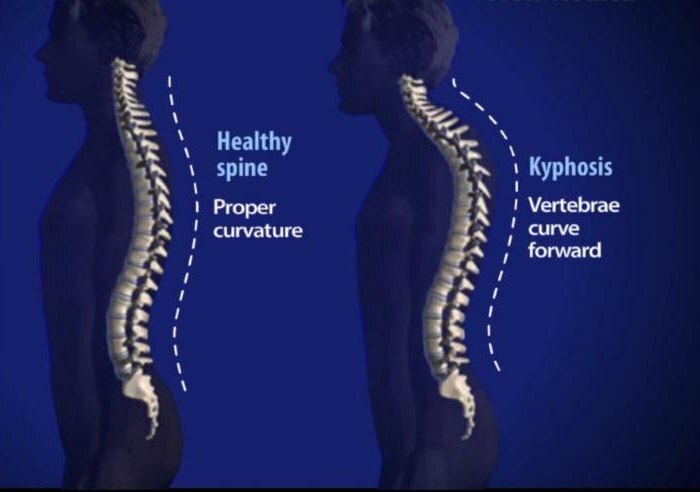
Kyphosis is a problem that is characterized by a strong curvature of the skeleton, in which a hump appears on the back. Most often the problem develops in the cervical and thoracic area, although it can be diagnosed in the lumbar spine.
Kyphosis is a pathology that is diagnosed if the angle of curvature exceeds 30 degrees. The disease can appear already in adolescence( from 10 to 15 years), although it is often diagnosed in the elderly. It should be noted that girls suffer less from this problem than boys.
Reasons for the development of the pathology
Kyphosis is a disease that can provoke such factors:
- Systematic and permanent violation of posture( during sitting or standing).Do not constantly bend at the table. And this rule should be observed from early childhood.
- Saddle, which appears with high growth.
- Weakening of the back muscles, in which they are unable to maintain the normal position of the skeleton.
- cerebral palsy.
- Pathological development of vertebral bodies. However, it can be congenital or acquired.
- Poliomyelitis. This serious childhood illness can leave a child with a disability for life.
- Osteoporosis( excessive brittleness of bones).
- Osteochondrosis.
- Spine operation.
- Rickets. This disease causes systemic disorders of the body.
- Injury of muscles or spine.
- Spondylitis( inflammation, leading to destruction of the vertebrae).
- Malignant lesions of the skeleton.
- Tuberculosis of bones.
Symptomatology of pathology
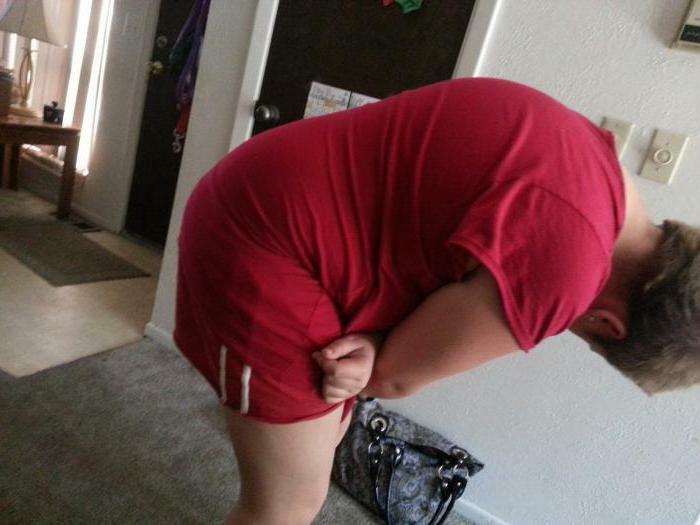
Thoracic spine kyphosis or other types of skeletal lesions may manifest as follows:
- Too much hump or stoop.
- Increased fatigue, the inability to perform long-term work while in one position.
- Pain in the area of curvature.
- Impossibility to carry out even small loads on the back.
- Numbness of the skin of the foot and back, and tingling in the limbs.
- Stiffness of movements.
- Kyphosis of the cervical region is characterized by the fact that the patient can not lift his head up.
Naturally, the presented disease causes disorganization of the work of other organs and systems, therefore may have additional symptoms:
- Frequent bronchitis and obstructive pulmonary disease.
- Pain in the heart of a aching character.
- Arrhythmia.
- Inflammation of the lungs.
- Pain in the right upper quadrant and abdomen.
- Noise in the ears.
- Pain in the head.
Diagnostic features of
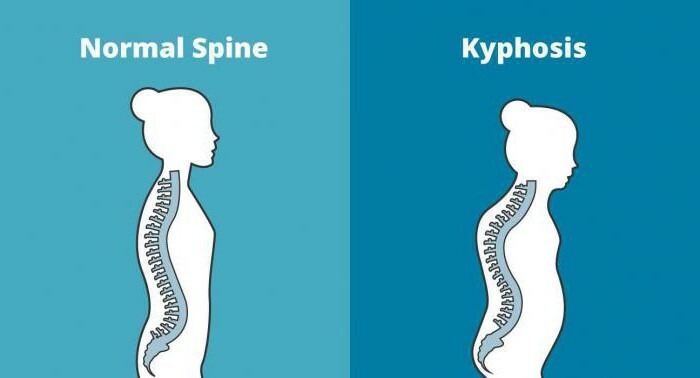
If you have kyphosis, treatment should be started immediately. Otherwise, the situation will rapidly deteriorate. Precisely to diagnose can only the doctor after a careful examination. The patient has to undergo such studies:
- External examination. First, the doctor will ask you to stand up straight to determine how big the hump is. Next you will need to bend over. In this case, the specialist determines the curvature of the skeleton in the lateral projection.
- Radiography. It shows the condition of the spinal column, although it does not give complete information about the features of the pathology.
- Computed tomography and MRI.Here, specialists will be able to get all the necessary information on the form and extent of the disease, on how badly damaged the body of the vertebrae.
Based on the findings, the doctor will be able to prescribe adequate treatment.
Species and degrees of the disease
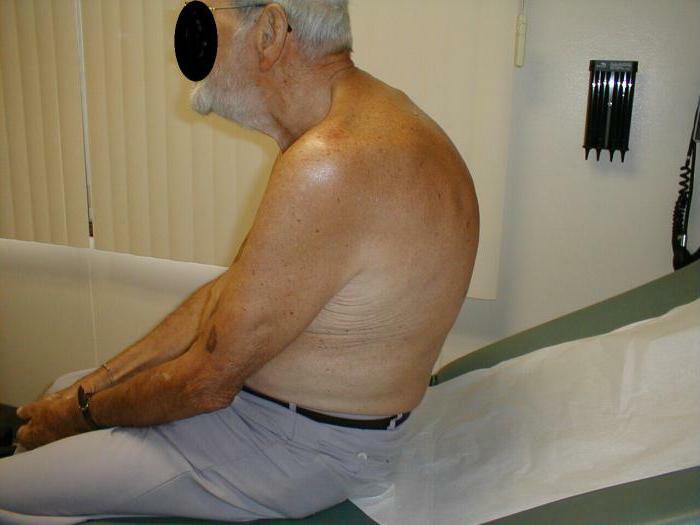
It should be noted that pathology can have a different origin. It is for this reason that the following types of kyphosis are distinguished:
- Paralytic.
- Postoperative.
- Functional.
- Degenerative.
- Ricky.
- Young dorsal.
- Post-traumatic.
- Congenital.
- Age.
The degree of kyphosis is necessary to know in order to prescribe the treatment that will really give a positive effect. There are only four of them:
- First. It is characterized by the smallest angle of curvature, which is 30-40 degrees.
- Second. Here the degree rises to 40-50 units.
- Third: 50-70 degrees.
- Fourth. It is characterized by the maximum level of curvature, in which the hump is seen very strongly, and the state of the skeleton is deplorable. The curvature is more than 70 degrees. In this case, traditional methods of treatment are rarely helpful. Most often at this stage, an operation is performed, which, unfortunately, can not always eliminate the consequences of the disease completely.
Features of some types of the disease
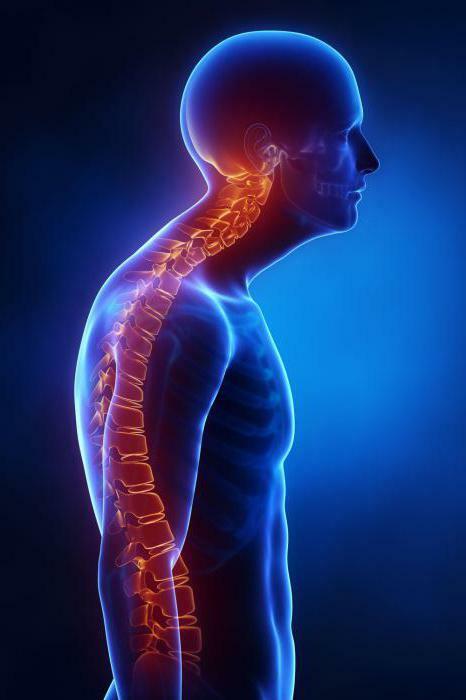
Before starting treatment, it is necessary to understand the characteristics of the main types of pathology. There are several of them:
- Kyphosis of the cervical spine. Treatment of this pathology is necessary, since without it a patient may have cerebral circulation. In the blood vessels, stagnation of blood occurs, and this is fraught with thrombus formation. The patient also has arterial hypertension, he is limited in movements with his head, suffers constant pain in his head. The presented type of pathology can develop even in newborns. The cause of this is birth trauma.
- Thoracic kyphosis. It is the most common. However, the diagnosis must be made correctly. The fact is that the presented disease can be confused with the kyphotic posture, which arises from the weakness of the muscular girdle. The back is hunching in this case, the shoulders are moving forward, the thorax seems hollow. During the progression of the disease, the patient develops a persistent muscular spasm. Further, there may be a decrease in the volume of the chest, there will be herniated vertebral bodies and their deformation.
- Lumbar kyphosis. It usually affects the 2 upper lumbar vertebrae. At the same time, the depreciation properties of the skeleton deteriorate.
Possible complications of
If the pathology is not treated on time, it is fraught with serious consequences. As a result of the development of kyphosis,
- may appear. Intervertebral hernia.
- Ischemic heart disease at an early age.
- Osteochondrosis.
- Urinary incontinence.
- Paralysis or paresis of the limb.
- Secondary meningitis.
As you can see, the complications are serious and complicated for treatment, therefore it is necessary to begin to correct the posture as soon as possible.
Traditional treatment of the disease
 With kyphosis it is necessary to fight. In the initial stages of the disease, such conservative methods can help:
With kyphosis it is necessary to fight. In the initial stages of the disease, such conservative methods can help:
- Medications. To stop the pain and remove inflammation, you can apply "Diclofenac".It would be superfluous to use chondroprotectors: "Teraflex", "Chondroitin".
- Therapeutic physical training. It is carried out for partial restoration of posture. In addition, physical education makes it possible to reduce the intensity of the pain syndrome, to tone the muscles and ligaments.
- Manual therapy. Massage promotes relaxation of the dorsal muscles, relieves pain.
- Physiotherapy treatment. This therapy allows you to restore blood circulation, reduces the intensity of pain, relieves fatigue.
- Use of a restraint corset. Thanks to this product, the patient has the opportunity to partially correct the posture, align the spine. In addition, the corset reduces pain, since it reduces the burden on the back.
Features of the surgical procedure
If the patient develops a curvature of the spine, the pain does not go away even when using conservative therapy, he is assigned a surgical operation. For this purpose, specialists apply special rods, which are fixed on the spine and align it. In addition, there is a two-stage operation. The first part of it involves the removal of the damaged or altered form of the vertebrae and the installation of implants. The skeleton in this case is fixed by a special metal construction. A few years later, a second operation is performed. It is necessary to remove the metal framework( if implant has taken root).
Please note that after the operation the patient will have to undergo a course of rehabilitation, which can last long enough. At first, it is better to use the services of a professional rehabilitologist. In the future, you can do the exercises yourself at home. 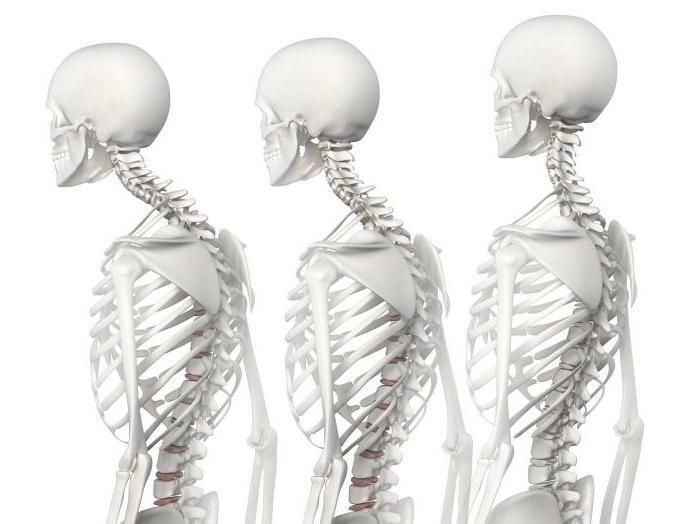
Preventative measures
To avoid the development of back problems, the following recommendations should be followed:
- Observe the correct posture. If you have a sedentary job, try to change position more often.
- Do not slouch while walking.
- Strengthen the muscle belt with exercise.
- Try to eat foods fortified with vitamins and minerals.
- Do not let spinal injuries or try to treat them on time.
- If the kyphosis has only begun to develop, rather consult the doctors. Treatment in the early stages will ensure a positive result.
Approximate complex of physical exercises
Physical exercises with kyphosis help strengthen muscles, prevent rapid progression of pathology. They are performed not only for rehabilitation purposes, but also for prevention. The complex can contain such exercises:
- Straighten the shoulders and tilt the body so that it keeps parallel to the floor. Then straighten up again. Repeat the exercise 10-15 times.
- From the supine position, lift the legs( alternately) upwards. Repeat the action 10-15 times with each foot.
- Well on the posture, hovering on the horizontal bar until the appearance of pain.
- From the standing position, make the torso slopes to the sides. In each direction you need to bend 10-15 times.
- Lie on your stomach. Then spread your hands to the sides. It is advisable to use light dumbbells. Try to tear off the upper part of the body from the floor. Hold for a few seconds in this position and lie down on the floor. Repeat this exercise 10 times.
The presented complex is very effective in the fight against kyphosis. It should also be performed to prevent disease. Now you know all the information about such a disease as kyphosis. Forms, causes, signs, symptoms and treatment are covered in the article. Please note that you need to consult a doctor with this pathology. Self-medication and folk methods here will not help. Be healthy!
